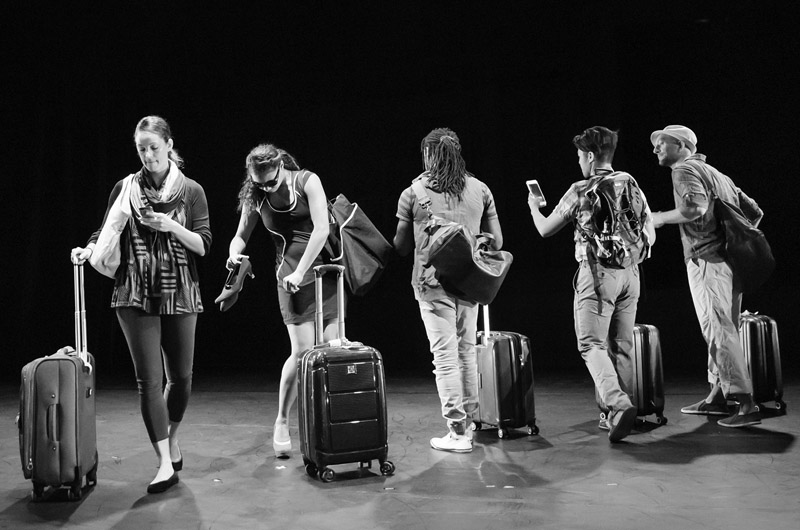“It’s not easy to find comic dance,” acknowledged David White, the artistic director of The Yard. “You think Singing in the Rain, maybe a few others . . . that’s kind of about it.”
Nevertheless, Mr. White has worked hard to put together a wide collection of acts for the Women Dance the Comic series at The Yard running until July 25.

“Some people just move funny,” said Abby Bender, a dancer who will be performing in two weeks with fellow comic dancer Cassie Tunick. “And some people are more comedians that like to put on a dance hat.” Ms. Bender is the founder of the annual Built on Stilts dance festival in Oak Bluffs, which also programs its share of comedic dances every summer.
The Yard’s three-week program features a variety of acts, all of which are created by women. Julia Rhoads, the artistic director of Lucky Plush Company, led the first performance in the series, held last weekend, with a piece titled The Queue. The piece is built around the misadventures of several airline passengers who are desperately awaiting a flight to Barcelona.
Dance comedy is often focused on the timing of a key moment, but The Queue incorporated a more narrative structure that featured dialogue alongside dance.
“We find more that our joy is finding humor from experience and out of relationship,” said Ms. Rhoads. “But there is still humor in dance that is still about timing or about the whole 5-6-7-8.”
This weekend’s performances bring together several different acts known more for their sense of the absurd. The following week will feature Ms. Bender’s production of Totally Other, which Mr. White describes as both “hilarious” and “perverse and bizarre.”
“In a good way!” he was quick to add.
One of the challenges of comedic dance is that dance is a movement based art and it can’t fully separate from that. But comedic dance can stretch the boundaries of the medium.
“The movement and the verbal can become these intertwining languages,” explained Mr. White. “And that is how you really communicate some of this humor.”
But comedic dance does not necessarily need dialogue, and some troupes eschew all the trappings of conventional theatre from the set pieces to the dialogue, and perform only based on the physicality of their bodies.
“I’ve seen works that have no props, they have no text,” said Ms. Bender. “It’s just the body moving really comically. And it can work.”
Given that the roots of early comedic dance go back primarily to male performers such as Buster Keaton or Charlie Chaplin, comedic dancing done by women, with or without dialogue, is less common. The field of dancing may be dominated in numbers by women, but as Ms. Bender explained, most household name dancers are still primarily men. The three-week festival is an opportunity to also explore the universe of women in comedy. The question of who’s funnier was part of what inspired the series in the first place.
Describing the state of comedy in what he referred to as “the age of Tina Fey and Amy Schumer,” Mr. White set out to explore this conversation through a medium that, admittedly, is sometimes overlooked as a comedic outlet.
“Ultimately, women are often funnier than men,” was how Ms. Bender put it. “And as time moves on, women are being more emboldened to be funny, especially in dance form.”
The series may help provide the breakthrough for larger female prominence in the dance community. Dancing that uses humor is often an enticing way to get people in the door.
“Dance, especially contemporary dance, can be somewhat alienating,” said Ms. Bender. “So a great gateway drug is comic dance.”
Week two performances of Wo men Dance the Comic are Friday, July 17, at 8 p.m. and Saturday, July 18, at 6:30 p.m. Week three with Abbie Bender and Cassie Tunick is Friday, July 24, at 8 p.m. and Saturday, July 25, at 6:30 p.m. Visit dancetheyard.org.








Comments
Comment policy »